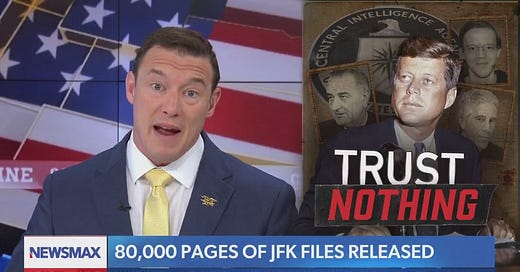In the shadowy world of classified intelligence, truth often emerges in fragments, decades after events have transpired. Such is the case with the assassination of President John F. Kennedy—an event that has captivated the American consciousness for generations and spawned countless theories about what really happened that fateful day in Dallas.
Recent declassifications have brought new information to light, confirming what many have long suspected: the official narrative presented by the Warren Commission may have been deliberately constructed to obscure deeper, more troubling realities about the assassination.
The Whistleblower Nobody Remembers
Have you ever heard of Gary Underhill? Most Americans haven't, yet his story provides a compelling window into the events surrounding Kennedy's death.
Underhill was no ordinary conspiracy theorist. As a former World War II military intelligence officer who later worked for the CIA on classified special assignments, he had insider knowledge of the intelligence community's operations. Shortly after the Warren Commission determined in 1964 that Lee Harvey Oswald had acted alone in assassinating President Kennedy, Underhill traveled from Washington D.C. to New Jersey to confide in friends.
What he revealed was explosive: according to newly unredacted reports, Underhill attributed Kennedy's murder to "a CIA clique which was carrying on a lucrative racket in gunrunning, narcotics, and other contraband and manipulating political intrigue to serve its own ends." He claimed Kennedy had "gotten wind that something was going on and was killed before he could blow the whistle on it."
Six months later, Underhill was found dead. The official ruling? Suicide—by a gunshot wound to the left side of his head. The troubling detail that investigators seemingly overlooked: Underhill was right-handed.
"People have come forward with information that incriminates big people or organizations that end up dead," notes the transcript. The pattern is disturbingly familiar to those who follow such cases.
The Route Change: A Fatal Detour
One of the most suspicious circumstances surrounding Kennedy's assassination was the last-minute change to his motorcade route in Dallas. Who authorized this change? The mayor of Dallas, Earl Cabell.
What makes this detail particularly troubling is that Cabell was, at the time of the shooting, a CIA asset. Even more damning, his brother Charles had been a senior CIA member who had been forced to retire from the agency the year before—by none other than President Kennedy himself.
This connection provides crucial context for understanding the tensions between Kennedy and the intelligence community that may have contributed to his death.
Kennedy vs. The Intelligence Community: A Fatal Rivalry
The Bay of Pigs and Kennedy's Vow
The relationship between President Kennedy and the CIA had deteriorated significantly following the Bay of Pigs disaster in April 1961. This failed invasion attempt of Cuba, which relied on faulty intelligence, left assets stranded in a swamp. Kennedy's decision to deny air support ultimately doomed the operation.
In the aftermath, Kennedy famously declared he would "splinter the CIA into a thousand pieces and scatter it to the winds." These weren't empty words—Kennedy took concrete action by disbanding the International Cooperation Administration (ICA), an agency that had served as cover for various intelligence operations.
USAID: Not What It Seemed
In place of the ICA, Kennedy established USAID. While publicly presented as a humanitarian organization, its creation was actually part of Kennedy's strategy to bring covert operations under greater accountability through the State Department.
"It really had absolutely nothing to do with building wells in Africa. Trust me, it was a cover," the Carl states, noting that such covers were common practice. "As a SEAL, I was in countries that we weren't at war with for humanitarian purposes too."
This restructuring represented a direct challenge to the intelligence community's autonomy and was perceived as a threat by entrenched interests within these agencies.
The Warren Commission: Investigation or Cover-Up?
The Convenient Appointment
One of President Lyndon B. Johnson's first acts after Kennedy's assassination was establishing the Warren Commission to investigate the killing. The commission's leadership raises serious questions about its objectivity and purpose.
Who led this supposedly independent investigation? Allen Dulles—the former CIA director whom Kennedy had fired. This glaring conflict of interest suggests the commission may have been designed not to uncover the truth, but to conceal it.
Policy Reversals Under Johnson
Following Kennedy's death, several significant policy reversals occurred under President Johnson's administration. Most notably, while Kennedy had intended to withdraw American forces from Vietnam, Johnson dramatically escalated U.S. involvement in the conflict.
These 180-degree policy shifts raise questions about whether Kennedy's assassination may have been motivated by opposition to his foreign policy agenda.
The Israeli Connection: What Remained Hidden
Perhaps the most intriguing revelation from recently declassified documents concerns what the CIA was most determined to keep secret. According to the transcript, the intelligence agency had "no oppositions to releasing most of this stuff years ago, but they did have one request for redactions: Any mention of Israel or Israeli intelligence."
Over a dozen instances cited in the recently released documents indicate that references to Israel were systematically redacted from previously released materials. While these documents don't explain why this information was considered so sensitive, the pattern of redaction raises profound questions about potential Israeli involvement or knowledge of the assassination plot.
"I don't have the answer to this, and these documents don't tell us," Carl acknowledges. "But this issue is part of the 1% that has been withheld all these years."
The Oswald Question: Lone Gunman or Patsy?
The official narrative has long maintained that Lee Harvey Oswald acted alone, motivated by his meetings with Cuban officials in Mexico City prior to the assassination. The Warren Commission suggested the killing was carried out as retaliation related to the Bay of Pigs invasion.
But the evidence increasingly suggests Oswald may have been exactly what he claimed to be when he stated, "I'm just a patsy"—a convenient scapegoat for a more complex conspiracy.
Systematic Disclosure
What's particularly troubling about the JFK assassination files is not just what they contain, but how they've been released. Carl explains how the government has "systematically leaked parts of the files over decades to the public, allowing for theories to be perpetuated for decades. Some of them were widely accepted as fact, even."
This pattern of selective disclosure raises the possibility that the drip-feed of information was itself a strategy—designed to confuse the public, discredit legitimate questions, and ultimately protect those truly responsible for Kennedy's death.
Conclusion: Trust, Transparency, and Truth
The newly declassified JFK files don't provide all the answers, but they do confirm what many have long suspected: the full truth about Kennedy's assassination has been deliberately withheld from the American people.
As Chuck Schumer once candidly admitted regarding President Trump's conflicts with intelligence agencies: "You take on the intelligence community, they have six ways from Sunday at getting back at you." This statement takes on chilling significance when viewed through the lens of what happened to President Kennedy after he challenged the CIA's authority.
The JFK assassination remains one of America's most profound tragedies—not just because we lost a president, but because the truth about his death has been obscured by the very institutions tasked with protecting our democracy.
This article is based on a transcript of reporting by Carl Higbie, who spent "the better part of last night and today at the very bottom of the rabbit hole on these JFK files."
News and Knees Substack is reader-supported journalism that brings you the stories mainstream media won't touch. If you value independent reporting that challenges official narratives, please consider becoming a paid subscriber. Your support makes this work possible and helps us continue digging for truth in a landscape of managed information.














Share this post